Low-Cost Additive Manufacturing Techniques Applied to the Design of Planar Microwave Circuits by Fused Deposition Modeling
Abstract
1. Introduction
2. Materials and Methods
2.1. Materials
2.2. D Printer
2.3. Manufacturing Process
3. Results and Discussion
3.1. Electrical Characterization at Microwave Frequencies
3.2. Structural Analysis
3.3. Microwave Circuits Proof of Concept
3.3.1. Microstrip Stepped Impedance Filters
3.3.2. Stripline Stepped Impedance Filters
4. Conclusions
Author Contributions
Funding
Conflicts of Interest
References
- Srivatsan, T.; Sudarshan, T. Additive Manufacturing: Innovations, Advances, and Applications; CRC Press: Boca Raton, FL, USA, 2015. [Google Scholar]
- Paolini, A.; Kollmannsberger, S.; Rank, E. Additive manufacturing in construction: A review on processes, applications, and digital planning methods. Addit. Manuf. 2019, 30. [Google Scholar] [CrossRef]
- Burton, H.E.; Peel, S.; Eggbeer, D. Reporting fidelity in the literature for computer aided design and additive manufacture of implants and guides. Addit. Manuf. 2018, 23, 362–373. [Google Scholar] [CrossRef]
- Kestilä, A.; Nordling, K.; Miikkulainen, V.; Kaipio, M.; Tikka, T.; Salmi, M.; Auer, A.; Leskelä, M.; Ritala, M. Towards space-grade 3D-printed, ALD-coated small satellite propulsion components for fluidics. Addit. Manuf. 2018, 22, 31–37. [Google Scholar] [CrossRef]
- Gholamipour-Shirazi, A.; Kamlow, M.-A.; Norton, I.T.; Mills, T. How to formulate for structure and texture via medium of additive manufacturing—A review. Foods 2020, 9, 497. [Google Scholar] [CrossRef] [PubMed]
- Velázquez, J.S.; Cavas, F.; Bolarín, J.M.; Alió, J.L. 3D printed personalized corneal models as a tool for improving patient’s knowledge of an asymmetric disease. Symmetry 2020, 12, 151. [Google Scholar] [CrossRef]
- Tanner, J.A.; Jethwa, B.; Jackson, J.; Bartanuszova, M.; King, T.S.; Bhattacharya, A.; Sharma, R. A three-dimensional print model of the pterygopalatine fossa significantly enhances the learning experience. Anat. Sci. Educ. 2020. [Google Scholar] [CrossRef]
- Berman, B. 3-D printing: The new industrial revolution. Bus. Horiz. 2012, 55, 155–162. [Google Scholar] [CrossRef]
- Leigh, S.J.; Bradley, R.J.; Purssell, C.P.; Billson, D.R.; Hutchins, D.A. A simple, low-cost conductive composite material for 3D printing of electronic sensors. PLoS ONE 2012, 7, e49365. [Google Scholar] [CrossRef]
- Huang, Y.; Wu, H.; Xiao, L.; Duan, Y.; Zhu, H.; Bian, J.; Ye, D.; Yin, Z. Assembly and application of 3D conformal electronics on curvilinear surface. Mater. Horiz. 2019, 6, 642–683. [Google Scholar] [CrossRef]
- Kim, K.; Park, J.; Suh, J.; Kim, M.; Jeong, Y.; Park, I. 3D printing of multiaxial force sensors using carbon nanotube (CNT)/thermoplastic polyurethane (TPU) filaments. Sens. Actuators A Phys. 2017, 263, 493–500. [Google Scholar] [CrossRef]
- Zhang, S.; Wang, B.; Jiang, J.; Wu, K.; Guo, C.F.; Wu, Z. High-fidelity conformal printing of 3D liquid alloy circuits for Soft electronics. ACS Appl. Mater. Interfaces 2019, 11, 7148–7156. [Google Scholar] [CrossRef] [PubMed]
- Macdonald, E.; Salas, R.; Espalin, D.; Perez, M.; Aguilera, E.; Muse, D.; Wicker, R.B. 3D printing for the rapid prototyping of structural electronics. IEEE Access 2013, 2, 234–242. [Google Scholar] [CrossRef]
- Kim, N.P. 3D-printed conductive carbon-infused thermoplastic polyurethane. Polymers 2020, 12, 1224. [Google Scholar] [CrossRef] [PubMed]
- Perelaer, J.; Smith, P.J.; Mager, D.; Soltman, D.; Volkman, S.K.; Subramanian, V.; Korvinkdf, J.G.; Schubert, U.S. Printed electronics: The challenges involved in printing devices, interconnects, and contacts based on inorganic materials. J. Mater. Chem. 2010, 20, 8446–8453. [Google Scholar] [CrossRef]
- Dahle, R.; Laforge, P.; Kuhling, J. 3-D printed customizable insert for waveguide filter design at X-Band. IEEE Microw. Wirel. Compon. Lett. 2017, 27, 1080–1082. [Google Scholar] [CrossRef]
- Ghazali, M.I.M.; Karuppuswami, S.; Kaur, A.; Chahal, P. 3D Printed high functional density packaging compatible out-of-plane antennas. Addit. Manuf. 2019, 30, 100863. [Google Scholar] [CrossRef]
- Rojas-Nastrucci, E.A.; Nussbaum, J.T.; Crane, N.B.; Weller, T.M. Ka-Band characterization of binder jetting for 3-D printing of metallic rectangular waveguide circuits and antennas. IEEE Trans. Microw. Theory Tech. 2017, 65, 3099–3108. [Google Scholar] [CrossRef]
- Ketterl, T.P.; Vega, Y.; Arnal, N.C.; Stratton, J.W.I.; Rojas-Nastrucci, E.A.; Córdoba-Erazo, M.F.; Abdin, M.M.; Perkowski, C.W.; Deffenbaugh, P.I.; Church, K.H.; et al. A 2.45 GHz phased array antenna unit cell fabricated using 3-D multi-layer direct digital manufacturing. IEEE Trans. Microw. Theory Tech. 2015, 12, 4382–4394. [Google Scholar] [CrossRef]
- Clower, W.; Hartmann, M.J.; Joffrion, J.B.; Wilson, C.G. Additive manufactured graphene composite Sierpinski gasket tetrahedral antenna for wideband multi-frequency applications. Addit. Manuf. 2020, 32, 101024. [Google Scholar] [CrossRef]
- Rocco, G.M.; Bozzi, M.; Schreurs, D.; Perregrini, L.; Marconi, S.; Alaimo, G.; Auricchio, F. 3-D printed microfluidic sensor in SIW technology for liquids’ characterization. IEEE Trans. Microw. Theory Tech. 2020, 68, 1175–1184. [Google Scholar] [CrossRef]
- Lai, W.; Wang, Y.; He, J. Electromagnetic wave absorption properties of structural conductive ABS fabricated by fused deposition modeling. Polymers 2020, 12, 1217. [Google Scholar] [CrossRef] [PubMed]
- Massoni, E.; Silvestri, L.; Alaimo, G.; Marconi, S.; Bozzi, M.; Perregrini, L.; Auricchio, F. 3-D printed substrate integrated slab waveguide for single-mode bandwidth enhancement. IEEE Microw. Wirel. Compon. Lett. 2017, 27, 536–538. [Google Scholar] [CrossRef]
- Flowers, P.F.; Reyes, C.; Ye, S.; Kim, M.J.; Wiley, B.J. 3D printing electronic components and circuits with conductive thermoplastic filament. Addit. Manuf. 2017, 18, 156–163. [Google Scholar] [CrossRef]
- Rogers Corporation. Copper Foils for High Frequency Materials. Available online: https://www.rogerscorp.cn/documents/749/acs/Copper-Foils-for-High-Frequency-Circuit-Materials.pdf (accessed on 5 August 2020).
- Rogers Corporation. Processing Guidelines for RO4400™ Bonding Layers. Available online: https://rogerscorp.com/-/media/project/rogerscorp/documents/advanced-connectivity-solutions/english/fabrication-information/fabrication-guidelines-ro4400-bonding-layers.pdf (accessed on 5 August 2020).
- Chaudhry, M.S.; Czekanski, A. Evaluating FDM process parameter sensitive mechanical performance of elastomers at various strain rates of loading. Materials 2020, 13, 3202. [Google Scholar] [CrossRef]
- Kerekes, T.; Lim, H.; Yeol, W.; Jin, G. Characterization of process–deformation/damage property relationship of fused deposition modeling (FDM) 3D-printed specimens. Addit. Manuf. 2019, 25, 532–544. [Google Scholar] [CrossRef]
- Rodríguez, A.; Sivilainis, L.; Dumbrava, V.; Chaziachmetovas, A.; Salazar, A. Automatic simultaneous measurement of phase velocity and thickness in Composite plates using iterative deconvolution. NDT E Int. 2014, 66, 117–127. [Google Scholar] [CrossRef]
- Hirao, M.; Ogi, H.; Sato, K. Interface Delamination of Layered Media: Acoustic Spectroscopy and Modal Analysis. IEEE Trans. Ultrason. Ferroelectr. Freq. Contr. 2004, 51. [Google Scholar] [CrossRef]
- Álvarez-Arenas, T.G. Simultaneous determination of the ultrasound velocity and the thickness of solid plates from the analysis of thickness resonances using air-coupled ultrasound. Ultrasonics 2010, 50, 104–109. [Google Scholar] [CrossRef]
- Livings, R.; Dayal, V.; Barnard, D. Damage detection in a multi-layered, multi-material composite using air-coupled ultrasonic resonance imaging. J. Nondestruct. Eval. 2016, 35, 55. [Google Scholar] [CrossRef]
- Hettler, J.; Tabatabaeipour, M.; Delrue, S.; Abeele, K.V.D. Detection and characterization of local defect resonances arising from delaminations and flat bottom holes. J. Nondestruct. Eval. 2017, 36, 2. [Google Scholar] [CrossRef]
- Castaings, M.; Siryabe, E.; Renier, M.; Meziane, A. Ultrasonic characterization of cohesive and adhesive properties of adhesive bonds. J. Acoust. Soc. Am. 2015, 138, 1766. [Google Scholar] [CrossRef]
- García-Martinez, H.; Ávila-Navarro, E.; Torregrosa-Penalva, G.; Delmonte, N.; Silvestri, L.; Marconi, S.; Alaimo, G.; Auricchio, F.; Bozzi, M. Design and fabrication of a band-pass filter with EBG single-ridge waveguide using additive manufacturing techniques. IEEE Trans. Microw. Theory Tech. 2020. [Google Scholar] [CrossRef]
- García-Martinez, H.; Avila, E.; Torregrosa Penalva, G.; Bronchalo, E.; Blanco Angulo, C.; Bozzi, M. Multilayered additive-manufactured half-wavelength coupled line filters. Int. J. Electron. Commun. 2020, 123, 153320. [Google Scholar] [CrossRef]
- Mundo Reader, S.L. BQ Hephestos. Available online: https://www.bq.com/en/support/hephestos/support-sheet (accessed on 4 July 2020).
- Ultimaker USA Inc. Software Ultimaker Cura. Available online: https://ultimaker.com/es/software/ultimaker-cura (accessed on 6 July 2020).
- Constanzo, S. Microwave Materials Characterization; Intech: Rijeka, Croatia, 2012. [Google Scholar]
- Chen, L.F.; Ong, C.K.; Neo, C.P.; Varadan, V.V.; Varadan, V.K. Microwave Electronics: Measurement and Materials Characterization; Wiley: Hoboken, NJ, USA, 2004. [Google Scholar]
- Pozar, D. Microwave Engineering, 2nd ed.; John Wiley & Sons, Inc.: Hoboken, NJ, USA, 1998. [Google Scholar]
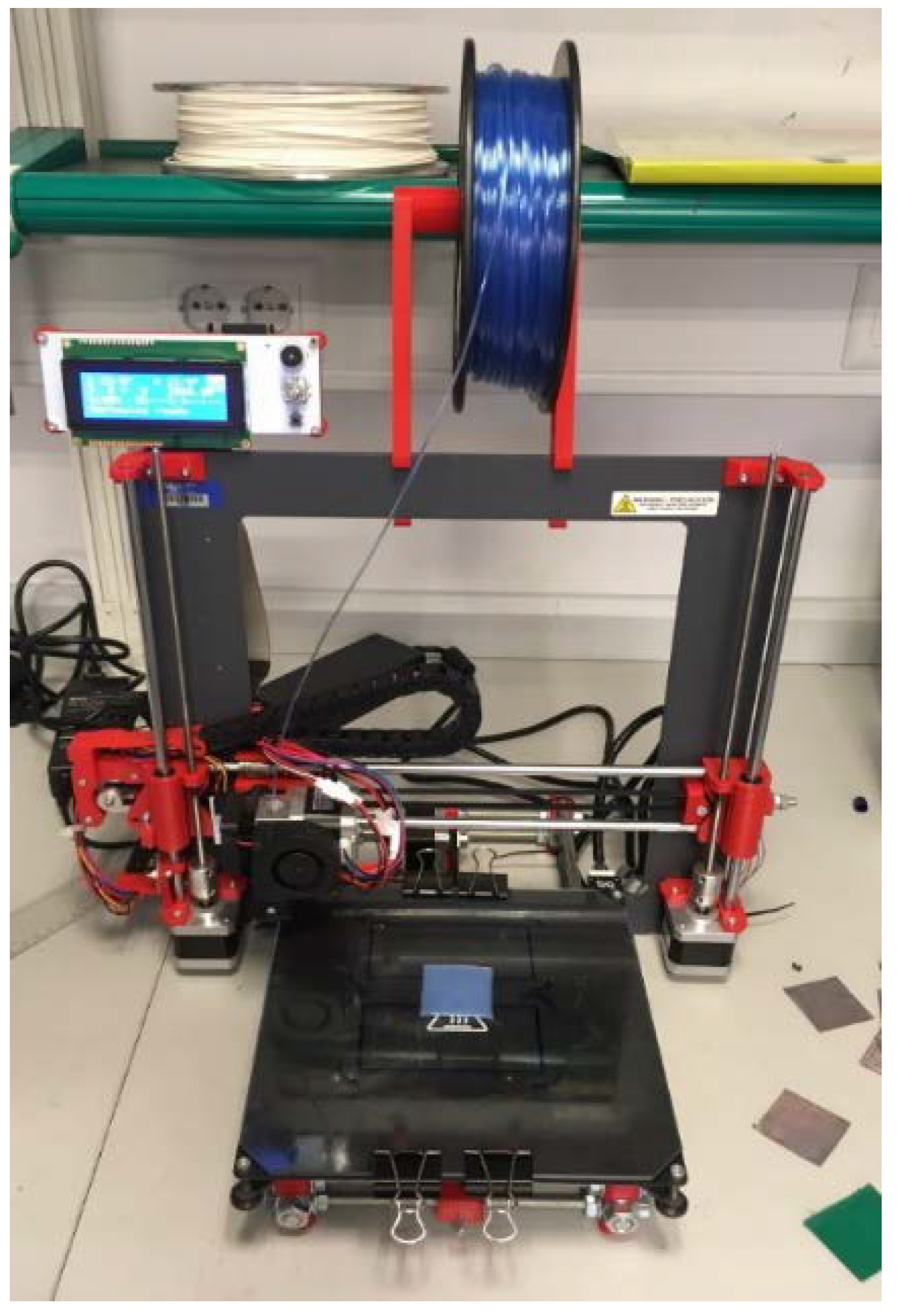


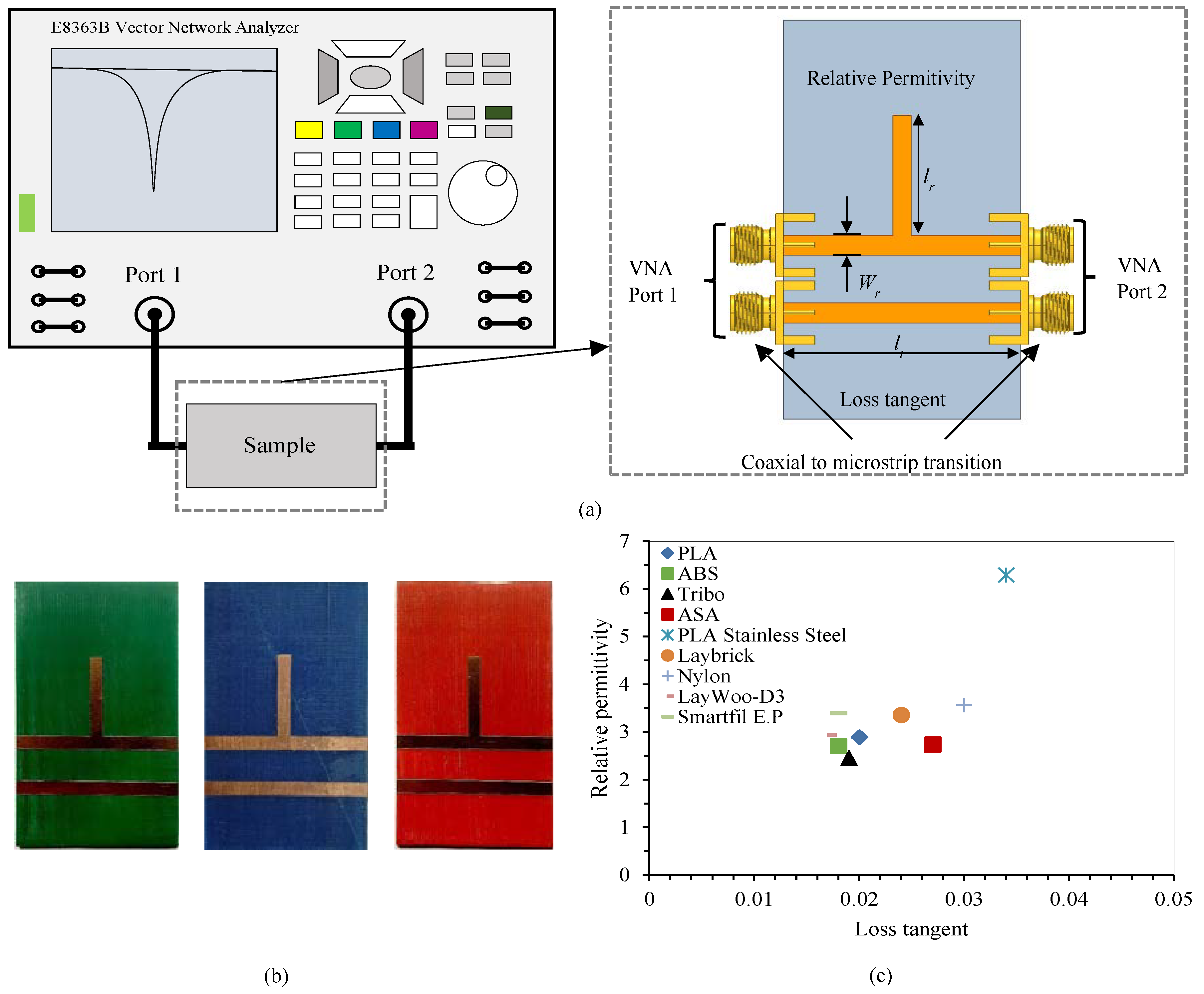
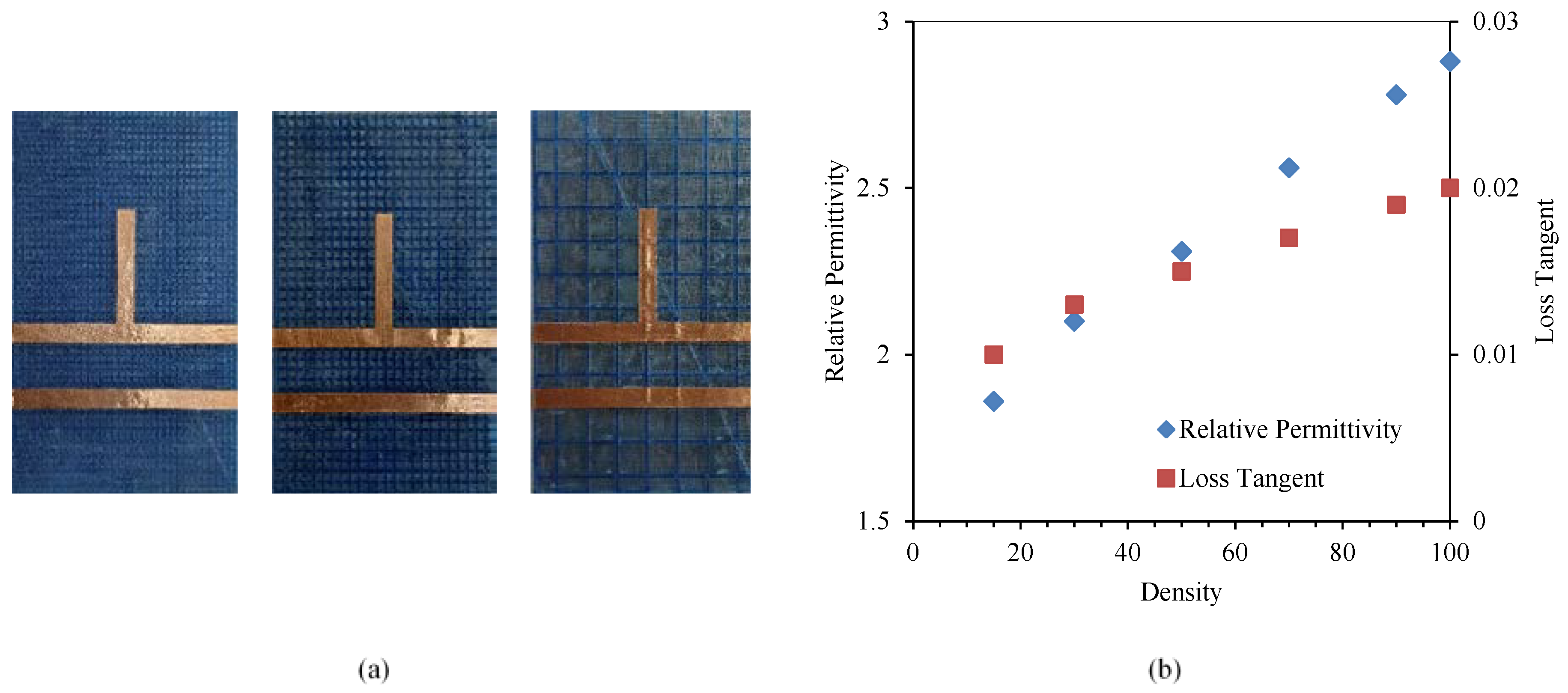




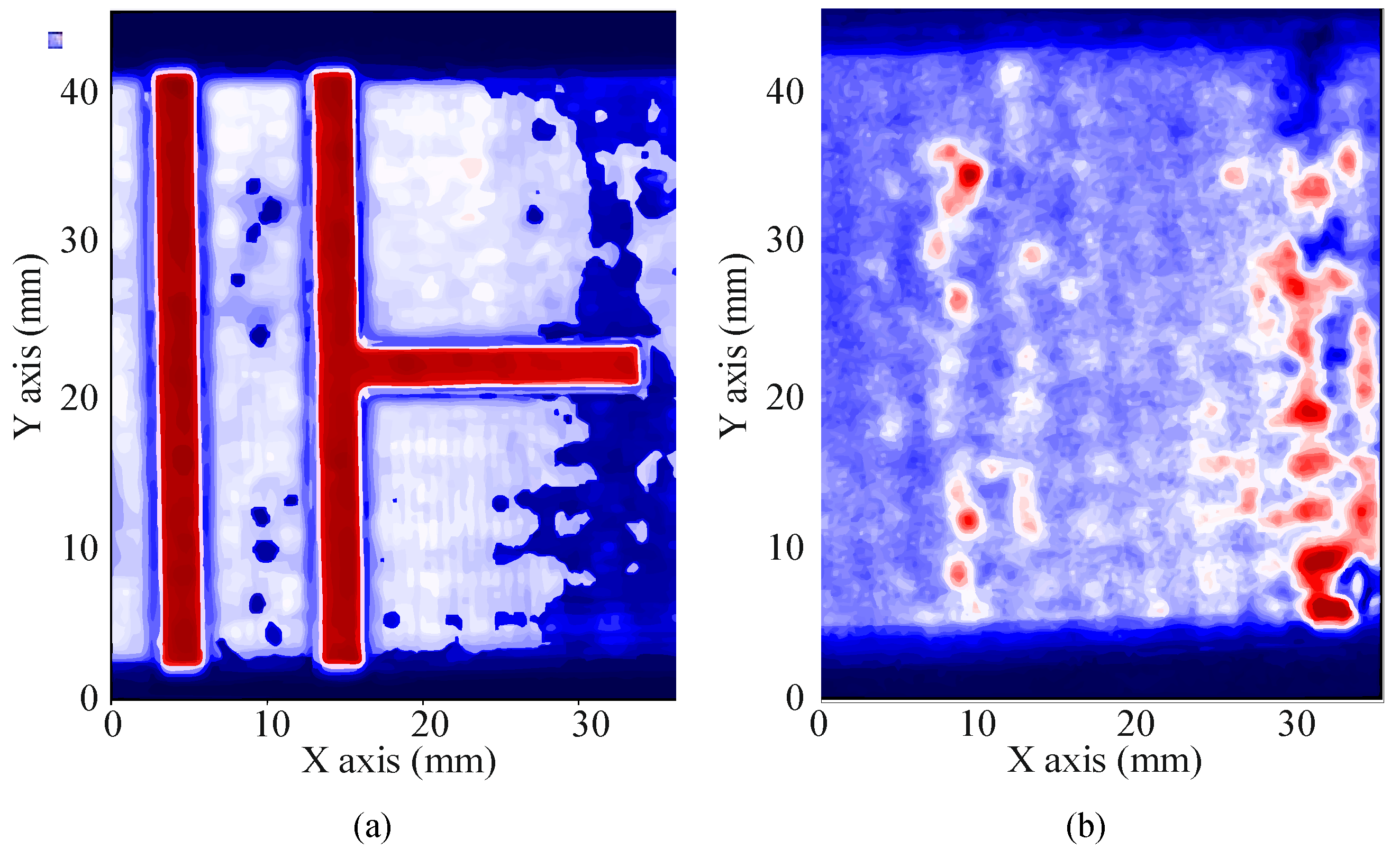
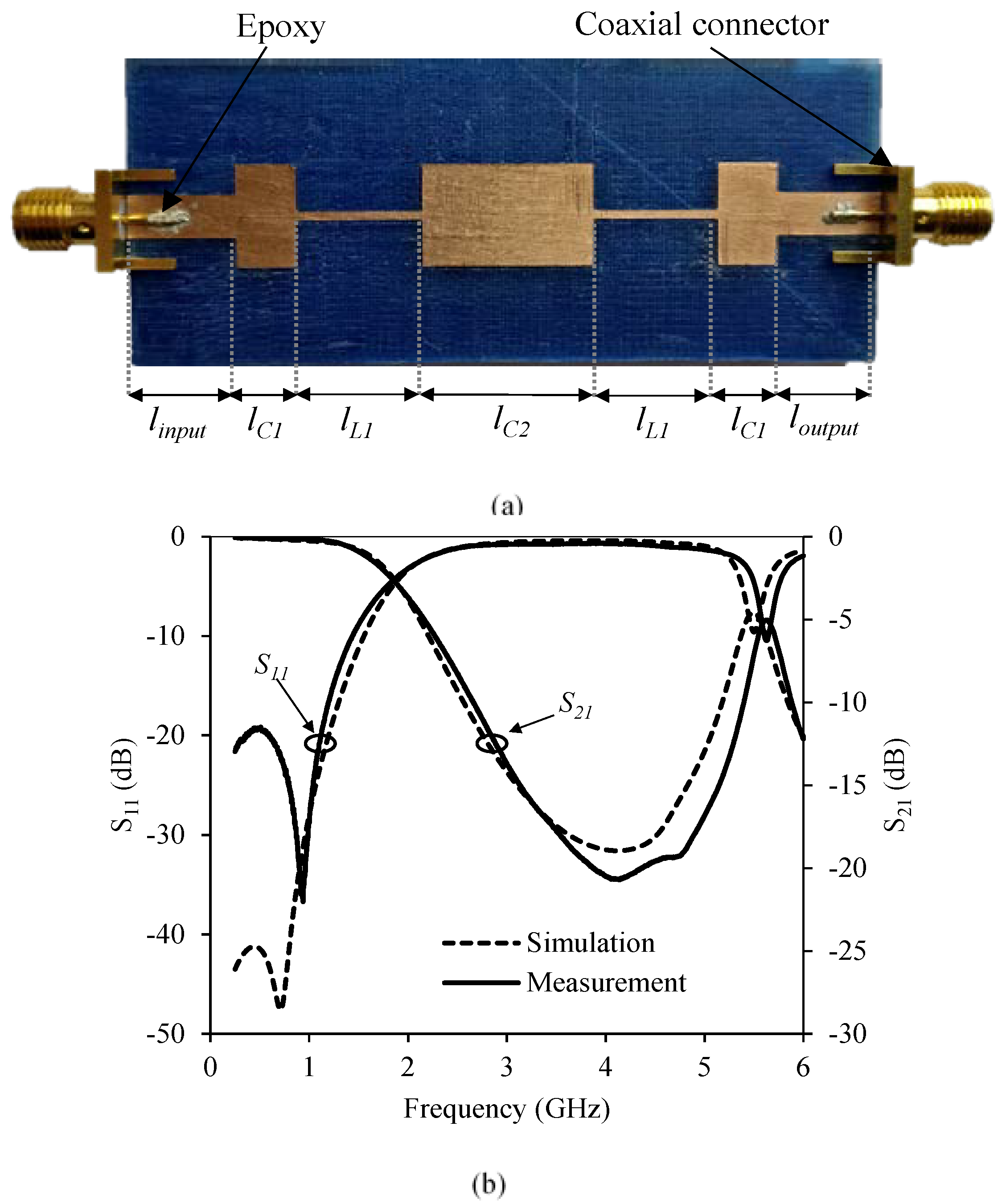



| 3D Printing Settings | |||
|---|---|---|---|
| Material | Extruder Temperature (°C) | Bed Temperature (°C) | Extruder Speed (mm/s) |
| PLA | 217 | 48 | 40 |
| ABS | 242 | 95 | 15 |
| Tribo | 256 | 100 | 20 |
| ASA | 255 | 100 | 20 |
| PLA Stainless Steel | 217 | 48 | 25 |
| Laybrick | 200 | 45 | 20 |
| Nylon | 237 | 50 | 15 |
| LayWoo-D3 | 220 | 45 | 20 |
| Smartfil EP | 202 | 40 | 30 |
| Parameter | Section Length (mm) |
|---|---|
| linput, loutput | 10.0 |
| lC1 | 4.63 |
| lL1 | 11.77 |
| lC2 | 14.67 |
| Parameter | Section Length (mm) |
|---|---|
| linput, loutput | 10.0 |
| lC1 | 4.63 |
| lL1 | 11.66 |
| lC2 | 14.67 |
| Parameter | Section Length (mm) |
|---|---|
| linput, loutput | 10.0 |
| lstrip | 5.0 |
| lC1 | 4.63 |
| lL1 | 10.78 |
| lC2 | 14.67 |
| Parameter | Section Length (mm) |
|---|---|
| linput, loutput | 10.0 |
| lstrip | 5.0 |
| lC1 | 4.63 |
| lL1 | 10.78 |
| lC2 | 14.67 |
© 2020 by the authors. Licensee MDPI, Basel, Switzerland. This article is an open access article distributed under the terms and conditions of the Creative Commons Attribution (CC BY) license (http://creativecommons.org/licenses/by/4.0/).
Share and Cite
García-Martínez, H.; Ávila-Navarro, E.; Torregrosa-Penalva, G.; Rodríguez-Martínez, A.; Blanco-Angulo, C.; de la Casa-Lillo, M. Low-Cost Additive Manufacturing Techniques Applied to the Design of Planar Microwave Circuits by Fused Deposition Modeling. Polymers 2020, 12, 1946. https://doi.org/10.3390/polym12091946
García-Martínez H, Ávila-Navarro E, Torregrosa-Penalva G, Rodríguez-Martínez A, Blanco-Angulo C, de la Casa-Lillo M. Low-Cost Additive Manufacturing Techniques Applied to the Design of Planar Microwave Circuits by Fused Deposition Modeling. Polymers. 2020; 12(9):1946. https://doi.org/10.3390/polym12091946
Chicago/Turabian StyleGarcía-Martínez, Héctor, Ernesto Ávila-Navarro, Germán Torregrosa-Penalva, Alberto Rodríguez-Martínez, Carolina Blanco-Angulo, and Miguel de la Casa-Lillo. 2020. "Low-Cost Additive Manufacturing Techniques Applied to the Design of Planar Microwave Circuits by Fused Deposition Modeling" Polymers 12, no. 9: 1946. https://doi.org/10.3390/polym12091946
APA StyleGarcía-Martínez, H., Ávila-Navarro, E., Torregrosa-Penalva, G., Rodríguez-Martínez, A., Blanco-Angulo, C., & de la Casa-Lillo, M. (2020). Low-Cost Additive Manufacturing Techniques Applied to the Design of Planar Microwave Circuits by Fused Deposition Modeling. Polymers, 12(9), 1946. https://doi.org/10.3390/polym12091946







